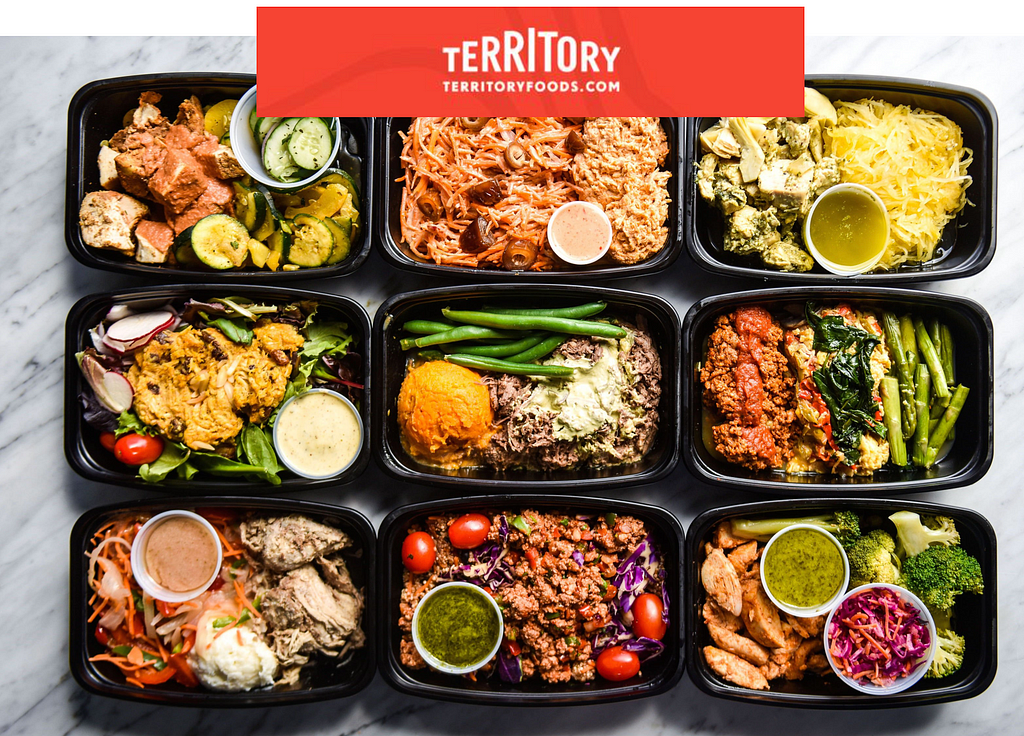
Yesterday I wrote about my weight loss journey of the past 18 months where I lost 65 pounds in 18 months with no gimmicks or fads. No paleo, keto, intermittent fasting — just sensible eating. If you didn’t read the post it might be worth clicking on the above link.
Some simple advice I have:
- Eating matters 10x more than working out. Both are important but as they say “you can’t outrun your fork.” In periods where I did MONSTER work outs (running 13 miles / day and still hiking afterwards) but eating more than normal I still gained weight. In periods where I worked out much less (or not at all) but stuck to my eating plan I always lost weight. It’s the simple.
- In my first post I talked about the need to have a good mental plan, measure everything and create ways to make yourself accountable. If you think you’re eating well but don’t measure things (both what you eat and how much you weigh) you’re flying blind.
Since it’s January 1st and I know many people are scrambling to put together plans for what to eat I thought I’d just start with a question I know is on many people’s minds, “what should I eat in 2021 to make it healthier than 2020?”
Have the right foods ready
So much of success in any endeavor is planning. If you have the right tools for the job you’re more likely to succeed. When I talk with people who struggle with weight I often hear something that was similar to my own behavior — at some point in the day you begin “snacking” and you reach for the wrong foods. Once your daily diet is out the window you might as well sabotage your day and start fresh tomorrow.
For me that meant if I had french toast for breakfast because I was feeling weak then I might as well have a cheeseburger for lunch. And annoyingly many times I would be perfect throughout the day only to find myself binge-eating ice cream in the evening.
Success for me in 2020 came down to have the right foods ready to reach for when I felt the need to eat and then holding myself accountable to portion sizes / calories / daily totals.
In the image at the top of the post I listed Territory Foods (which I must disclose we are an investor in). I list this because it’s truly the perfect food for managing your weight. It comes in fresh, single-serving packages for breakfast, lunch or dinner and you can select options that fit what your goals are in terms of eating. Many of the options are 400–600 calories, which is a great size for a meal if you’re trying to manage to 1500–1800 calories / day (many women) or 1800–2200 calories / day (many men).
All Territory foods are freshly prepared by local chefs or restaurants and their menus are designed to fit Territory’s healthy eating plans. Because you can choose menu items or chefs / restaurants you like it doesn’t immediately feel “same-ish” as many food platforms that are prepared in a centralized kitchen feel.
Another great option for is Daily Harvest. This got me through so many days during the pandemic. The foods are all natural so I felt like I was getting a great mix of fruit, vegetables and grains. All of the foods are dairy free, vegetarian and gluten free. Obviously you can add meat or cheese to any to your taste and I often found myself adding chicken to lunch bowls to add protein and calories.
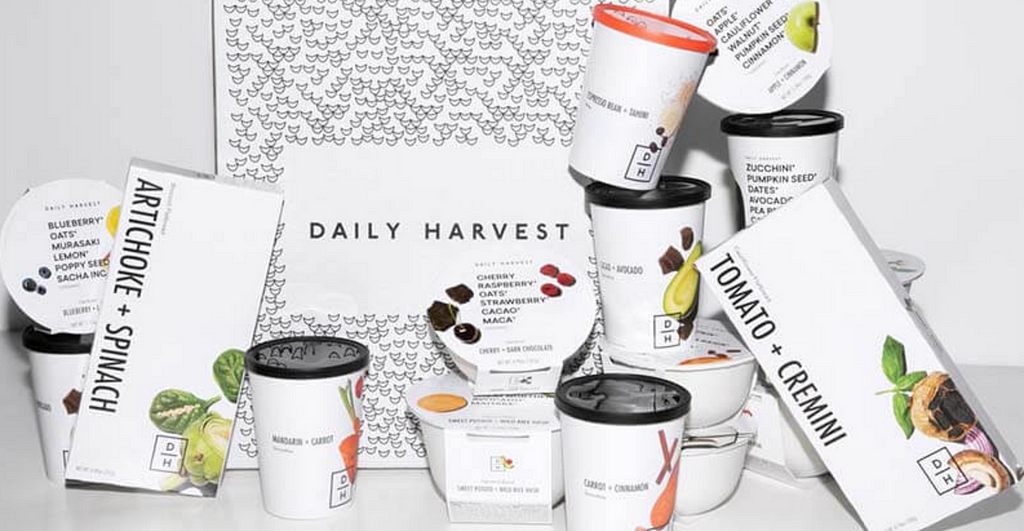
What I love about Daily Harvest is that everything comes frozen so I can have wholesome food in my freezer and available any time I need a meal or a snack.
In the summer I found myself making a lot of smoothies — each ranging from 250–400 calories and this would often be my breakfast with maybe a half a bagel or a piece of cinnamon raison toast. I make these in a blender with almond milk. Honestly, they feel like a cheat they’re so tasty.
They also have amazing “oat bowls” that cook in the microwave for 2 minutes and at lunch they have “grain bowls” that cook in 4–5 minutes and are typically 300–450 calories (thus I need to add some protein / calories or I’m too hungry).
The also have flatbreads that are gluten free and cook in my toaster over for 20 minutes so it’s a way to snack in the afternoon and these are typically 380 calories or so. Let me be clear — they are NOT as good as a slice of pizza or even a normal piece of flatbread. But since I was trying to end my day at 1800 “net calories” (total calories minus workout calories) being able to snack without blowing my daily totals was awesome.
Finally, we became a Blue Apron family during Covid. It was easy and quick to cook, had great variety and most options are 600–900 calories, which is perfect for dinner as long as I didn’t blow my daily targets by eating chips, nuts, candy or snack foods during the day.
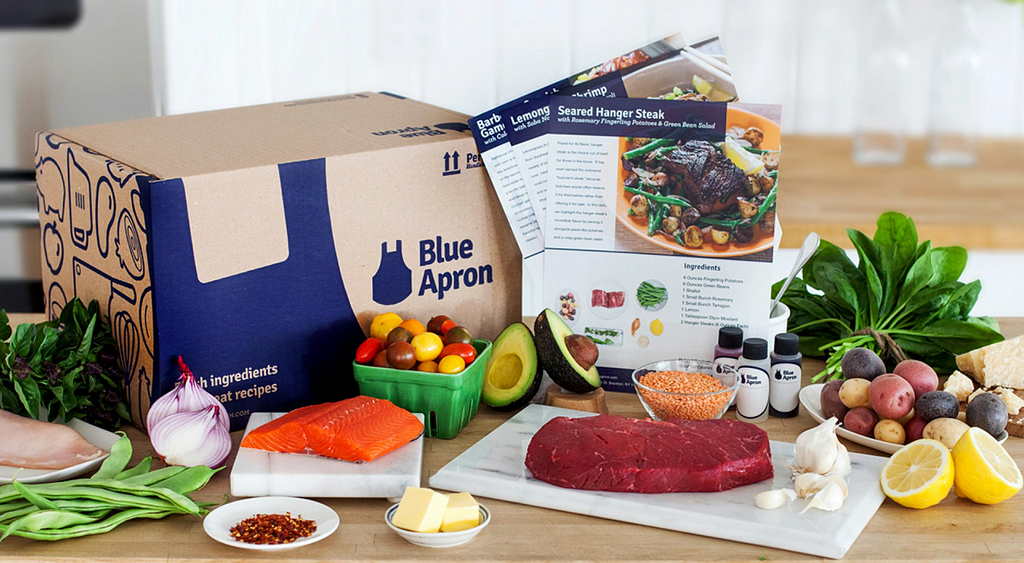
The variety on Blue Apron is fantastic and all of the food is super fresh and wholesome. We have two kids so it was the easiest thing to just standardize on something we could all eat.
Know calories and portion sizes
As I mentioned in my first post I used Noom for the 6 months of my weight management plan and then I switched to MyFitnessPal. Both work really well for keeping score of what you eat. As I mentioned in the first post, if you don’t count what you’re eating and if you end up eating even 300–400 calories extra / day it can be the difference between losing or gaining weight. Let me put it this way. If the average man should eat about 2,100 calories / day to maintain his weight (and 1,800 or so for women) then eating just 300 calories / day is like eating 8 days per week and not 7 (300 calories x 7 days = 2,100 calories).
Losing weight is about consistency and playing the long game. It’s about better habits and better daily choices. It’s about understanding the psychology of why you “cheat” or make bad decisions and finding ways to stop this behavior. I have always been a “stress eater” so recognizing this helps me a great deal.
What I learned by measuring what I eat I found out some interesting things:
- My portion sizes were way to fricking big. What I assumed was a “portion” of rice was really three portions. This quickly added 400–500 calories to any meal with rice
- What I thought a portion of cereal was was three portions.
- When I ate a bagel I always ate it with cream cheese or butter and one never seemed enough. Once I realized how many calories both a bagel and cream cheese have I made adjustments. I found myself making 4 egg whites and eating a half a bagel with a small amount of butter. This way I wasn’t depriving myself — I still got to eat bagels
- Mostly I learned to stop eating at restaurants a lot more. When you look at how much butter, cream, sugar and fat they add to everything to make it so tasty you realize why if you eat out a lot you’ll quickly gain weight. That simple.
- I learned to choose restaurants that have calories listed and to make better choices. I started eating Sweetgreen twice / week. They have tons of amazing options that don’t blow your eating plan. I enjoy Chipotle but learned that I need to eat the bowl not the burrito. The tortilla alone is 300 calories, which is a waste. I can eat a bowl with chicken and STILL eat the rice as long as I don’t have guacamole or cheese. It’s still awesome. Well, of course it’s better with sour cream, guac, cheese and wrapped in a lovely tortilla! But eating smart is about finding foods you love and modifying so that you can still enjoy them rather than restricting yourself.
So I eat what I want. I plan my day so that if I ate too much in the morning lunch is a bit lighter so that I can eat a normal dinner. If I plan to eat a lot at dinner I might make sure I worked out a bit longer in the day so I have extra calories to spare.
During my weight loss phase I tried not to go over my net calories target more than 3–4 times / month. And even then I would try never to really blow a day. If you go crazy even at one meal it often takes 2–3 days of healthy, perfect eating to get back to where you were before that cheat. In the end, that was never worth it to me.
Log during the day as you eat
For the past 9 months I’ve used MyFitnessPal religiously. It’s not perfect but it’s incredibly useful. It has millions of items in its database so I can type any kind of food and it will tell me the nutritional value and I can then easily track my daily calories. It also has a barcode scanner, which makes it dead easy to scan anything packaged like cereal, bread, milk, etc.
You must enter your food AS YOU EAT it, not try to remember what you ate at the end of the day and estimate it. It’s so easy to enter with your mobile phone that avoiding entering it is just an excuse. You manage what you measure and if you measure what you eat and hold yourself accountable you will lose weight and keep it off. That simple.
Develop strategies to have willpower in the evening
There is well known psychological phenomenon called “ego depletion” that posits that humans have a fixed amount of willpower so they can often resist temptations during the day only to run out of willpower in the evening and blow everything. This is my life. I could never quite figure out why I could be so great during the day and early evening only to become self-destructive at the last moment possible.
I should say that ego depletion as a theory isn’t settled and some psychologists think it’s rubbish but whether it’s real or not — it certainly fits my personal pattern so placebo or not I needed to find a way to deal with it.
For me personally I developed a couple of ways to stop my implosions. First, I would try to save 200–300 calories at the end of a day so that I knew I had room for a small “cheat” and didn’t feel like I was depriving myself. My go-to cheats were:
- popsicles (either 30 or 60 calories depending on size). Yes, they have sugar. But that’s the point. I feel like I’m eating something that doesn’t feel like I’m dieting so it fills an urge.
- 100-calories microwavable popcorn. In all my carb-free days I could never eat popcorn so having a small bag feels indulgent
- And finally, when I really want to stop all eating I would chew sugarless gum. Not just because it tasted sweet but because I had a rule that when I ate gum it meant that I wasn’t allowed to eat anything else that day. It was a Pavlovian signal and I made it a rule that I stuck to.
In my last post I spoke about Noom and the psychology of eating and becoming self aware of one’s behavior before making mistakes. Because I know that I’m most vulnerable in the evenings having a plan made me a lot more effective. And since I log 100% of what I eat and I never wanted to break my “net 1800 calorie” rule I found I could gamify myself into good behavior.
It was a strange feeling going to be hungry, as in I REALLY wanted to eat more and I woke up in the mornings feeling like I NEEDED to eat. And as days became weeks became months I realized that this is a normal human biological feeling and I had conditioned myself to the opposite. I now love waking up hungry. It has become a habit.
And it won’t surprise you that I sleep better as a result.
Find ways to hold yourself accountable
Everybody has their own way of motivating themselves to accomplish things and these follow either intrinsic motivations (things you do because you want to do good things for yourself) and extrinsic motivations (things that you do in order to please other people or not let others down).
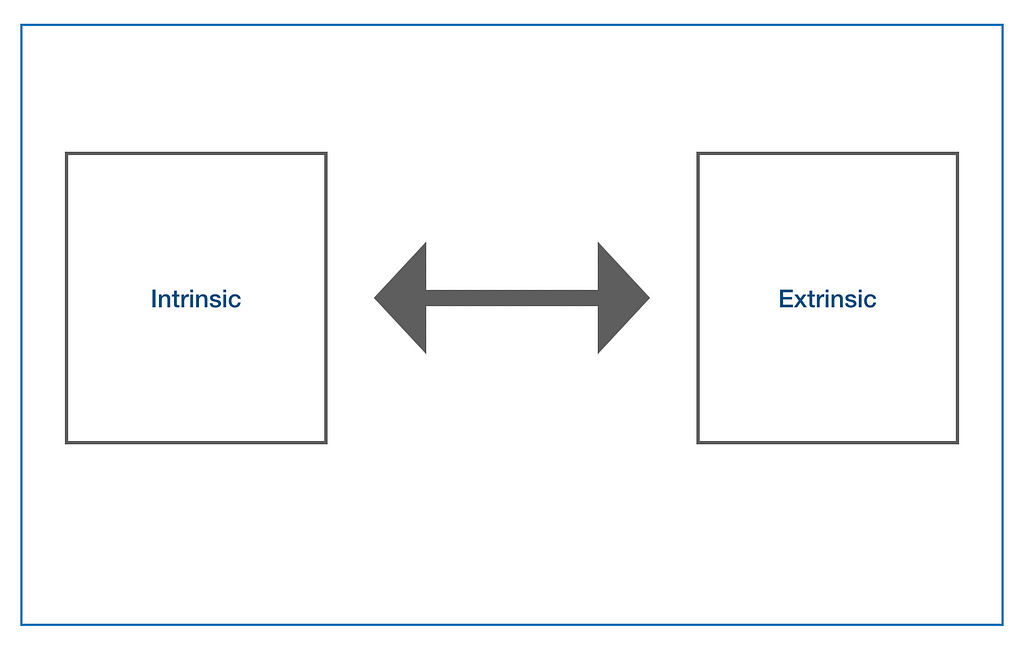
In my experience most people I know do better with extrinsic motivations, which is why having an “accountability partner” in weight loss can be so effective. If you have somebody you are checking in with and don’t want to let them down you are more likely to hold yourself accountable.
The problem is that in the early days of trying to control one’s weight it can be a very personal thing and often not something people want to share with others. I know that I didn’t want to tell anybody I was using Noom — in fact I never did until after I was already done using it and then I couldn’t stop telling people how effective it was since I had already lost 30 pounds.
But in the early days I found ways to gamify intrinsic motivations and make them seem extrinsic. Like with my Peloton where I didn’t want to “lose my streak.” It’s silly, really, because nobody even knows that I have a 61-week streak on Peloton (until now). If I broke it then kind of like the “broken windows” theory once I no longer have a streak to protect I might as well not worry if I I don’t Peloton for a few weeks.
So I hold myself accountable to the very tech tricks that are used to gamify my participation in the first place! I told myself I would never miss entering a meal on Noom or MyFitnessPal so I could keep my streak. I told myself that my weight could go up or down daily but that on each increment that the app showed it had to go down (1 week, 1 month, 2 months, 3 months).
Over time I started taking screen shots every day of my total calories eaten, burned and net calories and sending them to my brother so that I could create my own external accountability. Here’s what I sent my brother tonight (about 60 seconds ago).
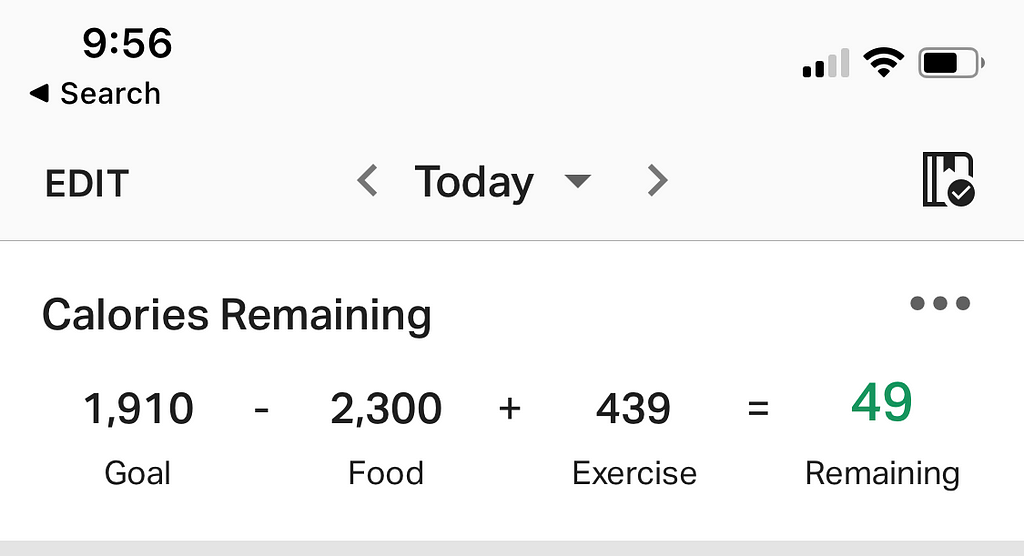
Avoid alcohol as much as possible
Alcohol is a diet killer. Not only are simple drinks like beer and wine 150–300 calories (and let’s not kid ourselves, who drinks one?) but they are also enablers of bad eating behavior. The drinks alone will likely fill 20–25% of your daily calories (and maybe I like food too much and would rather save it for eating).
You know this, of course. Alcohol lowers your inhibitions to “just one potato chip” or “just one fork full of chocolate cake. Alcohol also makes you sleep less well (despite what people think) and in reality probably adds more stress to your life than the stress you aim to relieve.
I’m not a teetotaler. I have 2–3 glasses per month. Either wine, beer or a whiskey. I enjoy it when I do. These days I notice more and more people sharing on social media that they’ve given up alcohol and most of the young people I know don’t drink nearly as much as we did (“we” being my generation) when we were young. This surely is a good thing.
So you might like the odd drink. I’m not going to talk you out of it on moral grounds. I would just weigh in practically. If you can cut back as much as possible I feel confident you’ll be happy you did. And at a minimum I would encourage you to resist the temptation to “drink to be social” or the ritual of drinking with meals because “that’s what you do.” It’s pointless, if you’re able to resist. Not everybody is, so no judgment from me if that’s the case. Good luck!
What I Ate on My Weight Loss Journey of 2020 was originally published in Both Sides of the Table on Medium, where people are continuing the conversation by highlighting and responding to this story.
via https://AiUpNow.com January 2, 2021 at 01:27AM by Mark Suster, Khareem Sudlow,
